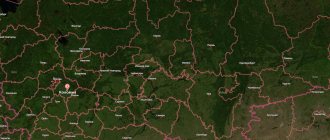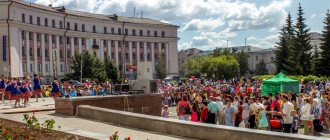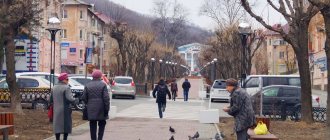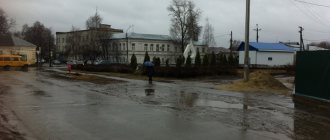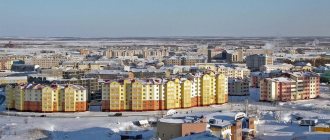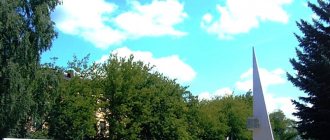Dubna
(until 1958 -
Dubno
), a city of regional subordination in the Moscow region, within the Dubna-Taldom deanery of the Sergiev Posad diocese. Located in the northernmost point of the Moscow region, on the banks of the Volga River, bounded by the Dubnaya and Sestra rivers, the Moscow Canal and the Ivankovsky Reservoir, 125 km from Moscow. The only settlement in the Moscow region located on the Volga. Population 67.9 thousand people (2010)
- On the map: Yandex.Map, Google map
The city of Dubna is known throughout the world as a major scientific center. Scientists from many countries around the world have been fruitfully collaborating here for more than half a century. This is the only Russian settlement immortalized in the Periodic Table of Elements by D.I. Mendeleev: “tannium” is the name of the chemical element 105 discovered by city scientists.
The confluence of the Volga and Dubna rivers was first mentioned in the Novgorod Chronicle in 1134. In 1216, during the war between the Novgorod Republic and the Vladimir-Suzdal Principality, the settlement that existed here was burned by the Novgorodians and was not restored afterwards. Subsequently, the village of Gorodishche and the village of Ratmino arose here.
The village of Ivankovo, located on the left bank of the Volga, was first mentioned in the 18th century. The nearest village of Podberezye has been known since the century, and the village of Yurkino on the Dubna River has been known since the 16th century. The village of Aleksandrovka was founded after the peasant reform in 1861. Here the landowner Prince A.S. Vyazemsky resettled part of the peasants living in the village of Ratmino, giving them land. The village of Kozlaki appeared in the same period. The inhabitants of these villages and the village of Gorodishche were mainly engaged in arable farming, shoemaking and fishing.
In the early 30s of the century, radical changes occurred in the life of the local population, which was associated with the construction of the Moscow Canal and the first Ivankovskaya hydroelectric power station on the Volga. Several surrounding villages were relocated. The village of Ivankovo was among them. Its inhabitants were resettled 4 km downstream of the Volga. And it began to be called Novo-Ivankovo. After the construction of the Volga hydraulic structures was completed in 1937, the workers' settlement of Bolshaya Volga began to grow nearby. Simultaneously with the construction of the Moscow Canal on the left bank of the Volga, the construction of an aviation enterprise was underway, next to which the aircraft manufacturing village of Ivankovo arose.
During the Great Patriotic War, Nazi troops were stopped 20 km from the villages of Ivankovo and Bolshaya Volga. They became frontline territory. Separate units, military courses and a hospital of the 30th Army of the Western Front were located here.
On the right bank of the Volga, near the village of Novo-Ivankovo, in 1947, on the initiative of the head of the Soviet atomic project I.V. Kurchatov began the creation of the world's largest charged particle accelerator in those years - the synchrocyclotron, which was launched in 1949. Dubno in 1954.
.
In 1953, the Institute of Nuclear Problems of the USSR Academy of Sciences was formed on the basis of the Hydrotechnical Laboratory of the USSR Academy of Sciences. After the creation by Western European countries of a nuclear research center (CERN) in the city of Geneva, in contrast to it, on the initiative of the Soviet Union, the Joint Institute for Nuclear Research (JINR) was formed in Dubno in March 1956.
On July 24, 1956, by Decree of the Presidium of the Supreme Soviet of the RSFSR, it was transformed into a city, and later transferred from the Kalinin region to the Moscow region. The village of Bolshaya Volga, the villages of Ratmino, Novo-Ivankovo, Aleksandrovka, Yurkino and Kozloki were annexed to it. In 1958 it became known as the city of Dubna
. The development of the new city was determined by the expansion of JINR.
On the left bank, the village of Ivankovo continued to develop, where, since 1939, the aviation enterprise produced aviation and missile equipment necessary for the defense of the country. In 1958, it was transformed into a city and transferred to the Moscow region, and in December 1960 it was merged with Dubna.
Since 1964, in Dubna, in accordance with the first master plan, the creation of a unified architectural and planning ensemble of the city began. This plan was further developed in a new master plan approved in 1984.
A new impetus to the development of Dubna, especially the oldest district of the city “Big Volga”, was given by the construction, which began in 1969, of the instrumentation plant, which already in 1973 produced its first products - instruments for nuclear power plants of the Soviet Union and CMEA member countries. In 1976, the Federal State Unitary Enterprise Research Institute “Atoll” was located in the same microdistrict, where the development of control systems for water areas of the Soviet Union began.
The city of Dubna is the largest scientific and industrial center in Russia and the Moscow region, with a developed system of education, culture, and healthcare, where high standards of living of the population were ensured.
In 1980, in connection with the opening of the XXII Olympic Games held in Moscow, the Dubna Space Communications Center began operating in Dubna, providing television broadcasts to the regions of Europe and the Atlantic Ocean and stable government telephone communications with the UK, USA, and France. Since that time, Dubna has become a major international teleport.
During the reform period of the 1990s, Dubna managed to maintain the profile of scientific and production activities and lay the foundations for innovative development.
In 1994, Dubna became a university center. The State International University of Nature, Society and Man “Dubna” was opened here.
In December 2001, by Decree of the President of the Russian Federation V.V. Putin, the city was given the status of a science city and a program for its development was approved.
In 2005, by decree of the government of the Russian Federation (dated December 21, 2005 No. 781), it was decided to create a special economic zone of a technology-innovation type in the city of Dubna.
Conferences “Science. Philosophy. Religion"
From 1990 to 1999, annual conferences “Science. Philosophy. Religion", the goal of which was to overcome the disunity between secular and church science and stereotypical ideas about the opposition between science and religion, inherited from the philosophy of the New Age, as well as the formation in the public consciousness of ideological positions that harmoniously combine religious, philosophical and scientific aspects of knowledge. Famous scientists and professors and teachers of higher educational institutions of the capital, and representatives of the clergy, professors and teachers of theological schools took part in the conferences.
After a long break, the tradition of holding annual conferences was resumed in 2007.
Soviet time
At the entrance to the canal, two monumental figures of the leaders of the world proletariat were installed - Lenin and Stalin.
To this day, the population of Dubna sees a monument to Vladimir Ilyich on the banks of the Volga, looking at the Volga. The figure of Stalin was dismantled after his death.
During the Great Patriotic War, the dam and hydroelectric power station in Dubna became strategic objects. Indeed, if they are destroyed, Moscow will be left without water and electricity, factories in the rear will stop, settlements and enterprises will be flooded. To protect the structures and the city, the dam's gates were opened, the water level dropped, the ice broke, and the German troops who entered the reservoir went under water. The Nazi offensive failed.
Religion
In a city founded in the era of developed socialism, the plan did not include places of worship. However, in a picturesque place - the spout of the Dubna and Volga rivers, there is the Church of the Praise of the Blessed Virgin Mary, built in 1827.
In the winter of 1993, in the area of the city cemetery of Dubna, a Temple was founded in the name of All Saints who shone in the Russian land.
In the summer of 1995, construction began on the Temple of the Smolensk Icon of the Mother of God in the left bank part of the city of Dubna in the old cemetery.
In the spring of 2000, an initiative group arose in Dubna advocating the construction of the Church of the Nativity of John the Baptist, the construction of which began in August of the same year.
Until 1994, Dubna was part of the Dmitrovsky deanery district of the Moscow regional diocese. In 1994, due to the increase in the number of parishes, the Taldomsky deanery district was established, which includes churches in the city of Dubna and the Taldomsky district. On October 9, 2007, at the diocesan meeting of the Moscow diocese, the Taldom deanery was renamed the Dubna-Taldom deanery with its center in the city of Dubna.
Since April 13, 2021, the city of Dubna has been located in the independent Sergiev Posad diocese as part of the Moscow Metropolis [1].
The city operates a non-state educational institution “Orthodox gymnasium “ODIGITRIA” at the Church of the Smolensk Icon of the Mother of God.”
The Saints
- sschmch. Mikhail Abramov (1885 - 1937), archpriest, rector of the Dubna Pokhvalinsky Church
Temples
- Epiphany, baptismal chapel at the Church of the Nativity of John the Baptist
- All saints who shone in the Russian land
- Daniel of Pereyaslavl, the temple-chapel is assigned to the Panteleimon Church
- Xenia of St. Petersburg (bell-baptismal tower at the Church of the Smolensk Icon of the Mother of God)
- Panteleimon the Healer
- Praises to the Blessed Virgin Mary
- Nativity of John the Baptist
- Smolensk Icon of the Mother of God
general information
Previously, it was believed that Dubna was a young populated center. However, materials have been found that prove its age at 800 years. The first settlement on the territory was founded by Yuri Dolgoruky in 1134. Since then, the village was burned, destroyed by the Mongol-Tatars and rebuilt later.
There are many attractions in Dubna - both related to physics, history, and nature. Here you can see museums, monuments, the embankment and other interesting places.
The city is constantly undergoing restoration of ancient objects, so it is better to pre-register for excursions. The guide will not only be able to conduct a tour, but also tell historical facts about Dubna.
Water is like a veil of mystery
Builders of Dubna began to develop the wooded abysses on the island between the Volga, Dubna and Sestra rivers from two independent sites.
The first scientific construction took place in documents as installation “M”. The construction of object “M” - a synchrocyclotron - was headed by Mikhail Grigorievich Meshcheryakov, who returned from the Great Patriotic War.
House of International Meetings (HIM) JINR_Yokki_wiki
“It was early spring with fogs and crisp snow. The railway could not be used: during the war, the rails were removed from the Verbilki - Bolshaya Volga branch, - M. G. Meshcheryakov recalled his first trip to the future Dubna in 1947. — We had to get there in a wartime jeep - it took two hours to get to Dmitrov along a badly broken highway, and then about another four hours we trudged along a road covered with round logs to the Big Volga, from where a caterpillar tractor took about two hours I dragged the jeep to the place where the Archimedes swimming pool is now located. There was damp forest all around, without any gaps.”
From Moscow to this place it was 125 km.
Everything that happened at the M facility was strictly classified. The construction area was protected from prying eyes by a barbed wire fence and was heavily guarded.
The synchrocyclotron was launched on December 14, 1949, on Stalin’s seventieth birthday.
To make what was created in the forests of the Moscow region more incomprehensible to the uninitiated, the new secret synchrocyclotron was called the Hydrotechnical Laboratory. The secret of nuclear research was covered with a curtain of water.
Relief
The city of Dubna is located on the southern tip of the Upper Volga flat lowland (120–150 meters) - the Volga-Dubna lowland, which has a smoothed flat topography, is swampy in places, and on the floodplain terraces of the Volga River. The city's topography was formed over a fairly long period of time, at least more than 1 million years.
The dissection of the territory is very insignificant, the scope of the relief does not exceed 1–3 m from the bottoms of gently sloping depressions, often forming closed and semi-closed hollows and depressions.
Dubna - reviews from those who moved
- + Leave a review
Leah
11/26/2021 at 3:01 pmAnswer
She moved 2 years ago from Moscow. From Plyusov there is a forest and the ability to get to any area except the left bank on foot. Of the minuses, there are no normal shops, nowhere to go to relax, the culture of the local population leaves much to be desired, as does the level of brains... Maybe at JINR there are brains, but in general the people are rednecks.
Yana
06/30/2021 at 22:20Answer
Today I was in Dubna for the first time on a tour! All! I fell in love with this city! I liked everything, the pine trees, the houses, the river, museums, the monument, the Moscow Sea, the atmosphere of the city! I live in the Klin district, Klin is far from Dubna with its garbage dump and Leningradka. Dubna, I want to live with you, with you, for the rest of my life! But I don't know how.
Anonymous
05.23.2021 at 17:11Answer
Chocks. Fucked up. Putin. Already. We moved. Everyone. Here.
Anonymous
05/23/2021 at 17:05Answer
Dull. For. You. I. Dubny.
Gennady
10/02/2020 at 20:57Answer
We live on Vernova 3a, 24/7 using the technological systems of the ATOL enterprise and others, the environment is getting worse every hour. The howl is such that your ears are withering, there is nowhere to turn, just a nightmare. The city has been taken over by production
Leave a review Reset
Ex-human
https://dubna.net/forum/viewtopic.php?p=1011320
Dubna is one of the best places to live. There is a direct railway connection with Moscow, and summer cottages at an affordable price, and country estates for agriculture in the Kimro district are inexpensive (from 1,500 rubles per hundred square meters!!! 1 km from the Volga River). And in general, as a native of these places (relatives from Korcheva), there are all the conditions for a budget holiday - swimming, fishing, gathering - what else is needed for happiness?
A good choice for starting a career for specialists is JINR, DMZ, Atoll, NIIPA, Tensor, SEZ, etc. - although the pay is below the market average for the region, but it depends.
Sinteposhka
https://dubna.net/forum/viewtopic.php?p=1011320
It's been almost 2 years since we moved here from Moscow.
Of the minuses: lack of a decently paid job, lack of 24-hour pharmacies (but now at home all the necessary medicines are always purchased!), tension with places in kindergartens in the region of BV and the CR, so if you are going to live here and have a child of kindergarten age, be prepared to take him to ICH or even on LB.
Medicine in my area in Moscow and here are the same. It's probably even better here. At least here the neurologist treated my back normally, but in Moscow they did nothing, and also for children, the doctor here is much better than our Moscow one.
On the plus side: everywhere and always on a bicycle, my 7-year-old son can calmly walk alone on the playground and no one bothers him, in BV we have everything at our fingertips: forest, shops, cinema, and all sorts of pizza and sushi. A huge plus: there is a forest nearby and in general the whole of Dubna is a very green city. There are also 4 places where you can swim: I’ll start with the coldest place: the Moscow Canal (clean and deep water), right next to the warmest place - Swan Lake, also clean water and decent depth, someone even dived in it with scuba gear. There is also the Moscow Sea (also warm, the beach is shallow for a very long time, in other places the depth is reached quickly) and the Volga (very cool water, although on hot days it still warms up, there is depth, but there is also a place for water with depth for children) . There is also a lake in the family recreation park, but the water is dirty, my children came down with an intestinal infection after one day of swimming there, so I don’t recommend swimming there.
Also in Dubna and nearby forests there are berries and mushrooms, and the city is full of places for fishing.
The city is quiet and calm, the residents are very nice and helpful.
In general, I, who have lived in Moscow all my life, when I came here for the first time, I realized that this is my city! It’s great here for me and my children!
MaVladia
https://eva.ru/house-and-hobby/messages-3030536.htm
Our friends, a married couple with 3 children, moved to Dubna, they rent quite decent housing, the children are all placed in schools, kindergartens, sections... They rent out their apartment in Sokolniki. They thought about moving permanently, but they didn’t seem to see much sense - they have Moscow registration with all the ensuing benefits + they rent out their own and this allows them to rent an apartment in Dubna of 100 sq.m. But they really like it there! We were visiting - a very calm city, many cars with Moscow license plates, many new houses that had just been built. I thought it was a bit boring there, but it’s okay for them! The air is definitely fresher than in Moscow.
Anonymous
https://www.domofond.ru/city-ratings/dubna-c3431
-There is no well-maintained beach, the Volga bank is littered. Tall houses are being built on the left bank. No parking. Problem with employment and low income. With such a location the city could be made into a resort city.
-the roads are just a nightmare!!! Like on a washboard!!! Road repair is a separate issue - the holes cut in the asphalt have not yet been repaired... By the way, the kindergarten has been under construction for 5 years already...
-Transport noise, gas pollution, parking everywhere.
-Lack of normal parking near the house, you have to park the car near another house near the road
Guest
https://www.woman.ru/home/medley9/thread/4816717/
I was born and raised in Dubna. In terms of nature, beauty and well-being, there is no better city. If you don’t know who writes about nuclear facilities, keep quiet. This is not a nuclear power plant with radioactive fuel, and in general you can live on the other side of the institute. Now the bridge has finally begun to be built. Everything in Dubna is wonderful. It has its difficulties, of course, but it is a beautiful city. Population only about 90,000, not 70
Rustic
https://22oa.ru/dubna-otzyvy-pereekhavshikh/
Dubna. Cultural scientific town. Near the Volga, pine forest. Full of shops and other service areas.
Tkristka
https://100realt.ru/uehat-iz-dubny-f633
Medicine is not satisfactory. The number of appointments with specialized specialists (for children and adults) is huge, and even the hospital does not have them on a permanent basis. It’s also paid by appointment, but it hurts now. Sometimes it’s easier to get to Moscow. There is little work for more than 30 thousand. Especially for women. Main job in trade. Housing is like in the near Moscow region. The only advantages are nature and the presence of children's equipment. institutions. There are no good or bad places, but there are disadvantages. For me it’s tolerable for now, but we’ll see.
Maglia Ivanova
https://22oa.ru/dubna-otzyvy-pereekhavshikh/
Dubna, cozy beautiful city, beautiful nature
vikoz
https://otzovik.com/review_1719095.html
Advantages:
shopping centers
Flaws:
people live in the middle of nowhere (left bank)
I have to go to the capital. The city is small, there is nowhere to go, people in the wilderness live worse than in the village; I’m talking about the left bank area. All those who are from large cities and Moscow, this city will seem boring to you
Lisa and Zlata
https://labrador.ru/ipb/topic/52177-who-lives-in-Dubna/
I'm from Dubna
